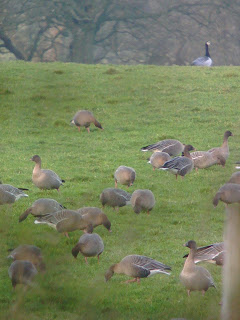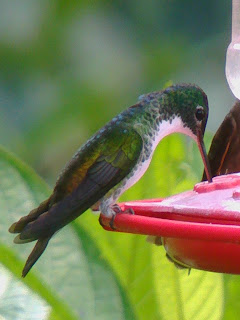For this years depression holiday, I visited my parents in south west Scotland, taking the opportunity to revisit a number of my old patches. I'm not sure whether it was down to the relatively mild weather (it reached double digits most days), but there were some significant changes in the 30 years since I regularly birded those area. There have been some notable increases - Barnacle Geese are far more common now (population up from about 3 - 4,000 to over 40,000), Little Egrets, Nuthatches and Magpies now resident. Bar-tailed Godwits have virtually dissapeared, to be replaced by Black-tailed Godwits. Duck and Gull numbers much reduced - no Potchard or Gadwall. Winter thrushes all but non existant - two sightings of single Redwings was all I could muster.
That said, I still managed some good sightings - all three regular Divers at Loch Ryan, along with Slave Grebes, Black Guillemots, Eider, Common Scoter, Scaup and Long-tailed Duck. Green-winged Teal and Waxwing at Caerlaverock, Ring-necked Duck at Castle Douglas.
My ongoing attempts to add Golden Eagle to my British list were thwarted yet again when the weather didn't read the forecast - the forcast clear skys never materialised - any Eagle in the area would of needed to land virtually on the car for me to see it, thanks to thick low cloud! It didn't help that when I returned to my partents they informed me that they had had amost unbroken sunshine all day.
One pleasing sighting was 6 Twite flying over Seafield. There was a regular wintering flock in this area but it died out in the late 70's / early 80's.
Pink-footed Geese, with a single Barnacle (there were more over the ridge) - an essential soundtrack to my youth as skeins regularly fly over town throughout the winter - around 300 flew over the house on Christmas Day morning. These were feeding less than a 1/4 mile from my former place of employment.
Drake Ring-necked Duck at Castle Douglas - the first bird I looked at on arrival
That said, I still managed some good sightings - all three regular Divers at Loch Ryan, along with Slave Grebes, Black Guillemots, Eider, Common Scoter, Scaup and Long-tailed Duck. Green-winged Teal and Waxwing at Caerlaverock, Ring-necked Duck at Castle Douglas.
My ongoing attempts to add Golden Eagle to my British list were thwarted yet again when the weather didn't read the forecast - the forcast clear skys never materialised - any Eagle in the area would of needed to land virtually on the car for me to see it, thanks to thick low cloud! It didn't help that when I returned to my partents they informed me that they had had amost unbroken sunshine all day.
One pleasing sighting was 6 Twite flying over Seafield. There was a regular wintering flock in this area but it died out in the late 70's / early 80's.
Pink-footed Geese, with a single Barnacle (there were more over the ridge) - an essential soundtrack to my youth as skeins regularly fly over town throughout the winter - around 300 flew over the house on Christmas Day morning. These were feeding less than a 1/4 mile from my former place of employment.
Drake Ring-necked Duck at Castle Douglas - the first bird I looked at on arrival


















































